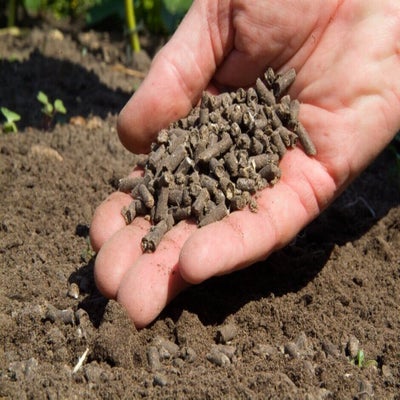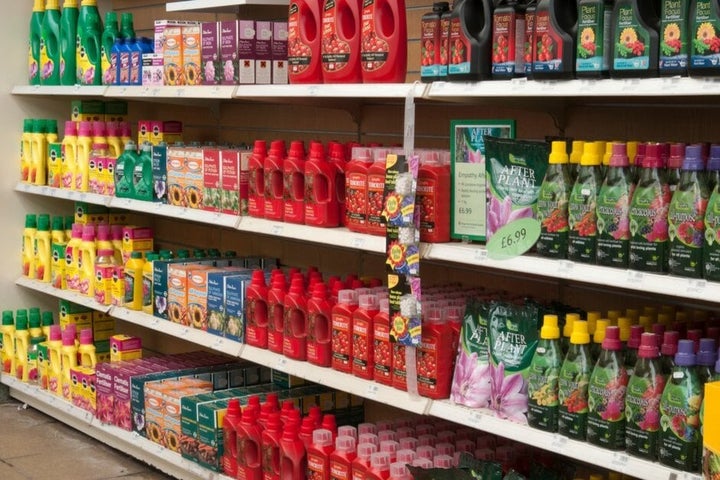
Quick facts
Fertilisers boost available nutrients for plant growth
Plants in the ground seldom need routine feeding
Organic fertilisers are derived from plants or animal by-products
Inorganic fertilisers are synthetic (chemically manufactured) plant nutrients or naturally-occurring mined minerals
They are available as liquids, granules, pellets or dry powders
Bought fertilisers have a large carbon footprint
Homemade fertilisers have a lower environmental impact
Incorrect application and overuse can cause pollution
Which plants benefit from fertilisers?
You don’t need to routinely use fertilisers in your garden. Most UK soils adequately feed plants without applications of fertilisers. If you opt to grow plants that naturally thrive in your garden, you will rarely need to feed. However, feeding can be beneficial for:
- and young plants raised in peat-free compost
- Plants in containers, including fruits, vegetables, ornamentals and houseplants
- Some fruits and vegetables growing in the ground
- Poor lawns may need feeding, but start by carrying out spring/summer and autumn maintenance to help them thrive first
- Plants showing signs of nutrient deficiency
For more information, see our guide on how to feed plants.
What are fertilisers?
Fertilisers are concentrated sources of plant that can improve growth. They are bought by gardeners as pellets, granules, powders and liquids.
General-purpose fertilisers contain at least three major nutrients (macronutrients):
- Nitrogen (N) supports vegetative growth (leaves and stems)
- Phosphorus (P) supports healthy root and shoot growth
- Potassium (K) supports flowering, fruiting and cold hardiness
Many fertilisers also contain the remaining three major nutrients (macronutrients): calcium (Ca), magnesium (Mg) and sulphur (S).
Additional nutrients called trace elements (micronutrients) are added to some fertilisers, particularly in specific plant foods such as ericaceous plant fertilisers. These are needed in much smaller quantities by plants and include boron (B), copper (Cu), iron (Fe), manganese (Mn), molybdenum (Mo), zinc (Zn).
What is the best fertiliser for your garden?
Choosing the right fertiliser from the dozens available to buy and make at home can be daunting.

Be eco-friendly
Keep fertiliser use to a minimum. The production, packaging (often plastic), transport and risk of polluting water has an environmental cost. High levels of nutrients in the soil also have a negative impact on soil health, inhibiting the activity of soil microbes including beneficial mycorrhizal fungi.
Below is further information about the types you’ll find for sale, their origins, uses and environmental impact. There are two main types of fertiliser – organic and inorganic.
We list the NPK ratio to indicate the proportions of nitrogen, phosphorus and potassium, which helps gardeners choose the right fertiliser for their needs. These NPK ratios are the ROI/IRL/EU values from the product labels. They provide the easiest indication of the NPK contents without the more complex interpretation needed for UK labelling. For more information, read Fertiliser Labels Explained.
Organic fertilisers
Organic fertilisers are effective, but usually less concentrated and slower acting than inorganic options (see below). They typically have a smaller carbon footprint. Organic fertilisers are derived from living things (carbon-based) and fall into two groups:
- Plant-based – seaweed, sugar beet, digestate, comfrey and nettles
- Animal-based – hoof & horn, dried blood, fish, blood & bone, bone meal and poultry manure
Did you know?
The term ‘organic’ has a different meaning when applied to food production and organic growing: it usually refers to not using synthetic inputs such as pesticides and fertilisers.
Types of organic fertilisers
Dry fertilisers
Powdered or pelleted organic fertilisers release slowly because they need to be broken down by soil organisms. This means they feed plants for a longer period. Examples include:
- Westland Organic Chicken Pellets (NPK: 4.5–1.5–2.5) – general fertiliser, higher in nitrogen to promote green growth
- Vitax Organic Potato & Vegetable Fertiliser (NPK: 4–1.1–6.6) – higher in potassium, promotes cropping and flowering
Liquid fertilisers
Available in bottles or pouches. Generally faster acting than ‘dry’ organic fertilisers. Best used for plants in containers and to remedy nutrient deficiencies. Examples include:
- Maxicrop Seaweed Tomato Growth Stimulant & Feed (NPK: 4–0.8–4.9) – promotes flowering, cropping and general growth
- Phostrogen Organic All Purpose Liquid Plant Food (NPK: 3–0.9–5.8) – promotes cropping and flowering
Are organic fertilisers more environmentally friendly?
Just like inorganic fertilisers, organic fertilisers require processing, packaging and transport. For the lowest carbon emissions, choose dry organic pellet fertilisers. However, it is better to feed your soil by home composting, using a wormery and making your own fertiliser.
Inorganic fertilisers
Inorganic fertilisers are usually more concentrated and faster acting than organic options. They have a higher environmental impact and you’ll need to apply them according to the instructions to avoid plant damage and water pollution. Inorganic fertilisers (those containing no carbon) fall into two groups:
- Synthetic fertilisers made in a chemical process – for example, nitrogen fertilisers are formed from nitrogen gas from the air
- Minerals mined from the ground – for example, rock phosphate, kieserite (magnesium sulphate), magnesium salts and ground limestone (calcium carbonate)
Good to know
Some organic fertilisers contain naturally occurring mined minerals, such as rock phosphate, rock dust and kieserite (magnesium). Although inorganic, they aren’t synthetic so are accepted under most Soil Association organic growing guidelines.
Types of inorganic fertilisers
Dry fertilisers
Available as powders, pellets and granules. Apply to the soil or mix with peat-free potting as stated on the packaging. Examples include:
- Growmore (NPK: 7–3.1–5.8) – general fertiliser, but higher in nitrogen to promote growth
- Sulphate of Ammonia (NPK: 21–0–0 + Sulphur) – very high nitrogen to promote growth
- Sulphate of Potash (NPK: 0–0–48 + Sulphur) – very high potassium to promote cropping and flowering
- Epsom Salts (NPK: 0–0–0 + Mg) – helps with magnesium deficiency
Liquid fertilisers
Available in bottles and as soluble powders. Generally fast acting and best used for plants in containers and to remedy nutrient deficiencies. Examples include:
- Miracle-Gro All Purpose Soluble Plant Food (NPK: 24–3.5–13.3) – general fertiliser, but high in nitrogen to promote growth. It also has a high potassium content to promote flowering and fruiting
- Phostrogen All Purpose Plant Food (NPK: 16–4.4–19.9) – general fertiliser, but high in potassium to promote cropping and flowering
- Levington Tomorite Concentrated Tomato Food (NPK: 4–1.3–6.6) – high potassium to promote cropping and flowering
When and how to apply fertilisers
When and how to apply fertiliser depends on the product you are using. Always follow fertiliser product instructions for the correct method of application, timing and dosage.
When to feed:
Spring
Dry organic feeds, such as fish, blood & bone, poultry manure pellets, comfrey pellets and seaweed meal, are scattered (a top dressing or base dressing – see below) from February to March as they release more slowly so are applied early.
Inorganic feeds, such as Growmore, are scattered (a top dressing or base dressing – see below) later, from March to April, as they are fast acting.
Spring and Summer
Liquid feeds (see below) for houseplants and outdoor plants are mixed into the water and applied during the growing season, from April to September. Some can be applied to the leaves as foliar feed (see below).
Summer lawn feeds are applied as top dressings when the soil is moist and the grass is growing.
Autumn
Lawn fertilisers specifically for use in autumn are applied from when the soil is moist in September until mid-October, ideally before the first frosts.
Top tip
Feed plants with fertilisers only when required. Very few plants need fertiliser in the winter months, even if they are winter flowering.
How to feed
There are four main methods of applying feed to plants. Use the ones described on your product for best results.

Top dressing
Scatter fertiliser on the soil surface around the base of plants.
Example:
To feed fruit trees and soft fruit. Use an organic, slow-release fertiliser such as fish, blood & bone.

Base dressing
Mix fertiliser into potting compost or the top layer of soil before sowing or planting.
Example:
Fork a fertiliser into the top layer of soil before sowing vegetable seeds, for example Vitax Organic Potato Fertiliser.

Liquid feeding
In a watering can, dilute liquids, soluble powders, granules and homemade fertilisers. This is watered onto the ground or into pots where plants are growing.
Examples:
Feed vegetables and ornamental plants in containers or growbags with a fertiliser such as Maxicrop Seaweed Tomato Growth Stimulant & Feed.
Feed young plants and seedlings raised in peat-free seed compost with a fertiliser such as Elixir Gardens High Nitrogen Liquid Plant Food.

Foliar feeding
Apply a diluted fertiliser to the leaves of plants with a sprayer or a watering can fitted with a fine rose nozzle on the spout. Spray soft young leaves and the undersides of leaves for good absorption. Spray on dull days to avoid leaf scorch.
Examples:
Boost the health of plants affected by problems, such as rose black spot, using a spray such as Maxicrop Plus Complete Garden Feed (5–2.2–4.2).
Help correct nutrient deficiencies. Common examples include magnesium deficiency in tomatoes and raspberries, which can be helped by applying a spray of diluted Epsom salts.
Fertiliser jargon explained
Here’s our guide to understanding commonly seen terms in fertiliser information and on the product labels:
Plant feeds and foods
Food is another name for fertiliser. Feeding is the act of applying a plant food/fertiliser – it’s also called fertilising.
All purpose, general purpose or multi-purpose fertilisers
These are ‘compound’ fertilisers: they contain several nutrients. Most contain the three major nutrients – nitrogen (N), phosphorus (P) and potassium (K). These fertilisers support leaf, shoot and root growth, flowering and cropping. Some also contain other major and trace elements. Such fertilisers, Growmore for example, are sometimes called ‘balanced’ as the proportion of nitrogen (N), phosphorus (P) and potassium (K) appear to be similar. Examples include:
- Organic – Fish, blood and bone and pelleted chicken manure
- Inorganic – Growmore and Vitax Q4
Straight fertilisers
These contain just one, or predominately one, nutrient and are usually inorganic. They are used to provide particular nutrients to boost growth or to correct nutrient deficiencies. Examples include:
- Sulphate of potash (S and K)
- Epsom/magnesium salts (Mg and S)
- Sulphate of ammonia (N and S)
Controlled-release fertilisers
These are granular or pelleted inorganic fertilisers, coated with a porous material such as sulphur, wax or synthetic plastic resin. They work by absorbing water and then slowly releasing fertiliser into the surrounding potting . Examples include:
- Miracle-Gro All Purpose Continuous Release Plant Food
- Osmocote
Slow-release fertilisers
These are organic fertilisers that break down with the help of soil micro-organisms and release their nutrients over a period of many months. Examples include:
- Hoof & horn
- Bone meal
- Comfrey pellets
Chelated (sequestered) fertilisers
Chelates are used for correcting nutrient deficiencies, such as iron deficiency. They contain a micronutrient, commonly iron (Fe), that is bound to a chelating agent (complex organic or inorganic compounds). The resulting ‘chelate’ ensures the micronutrient remains available to plants. An example of this is where iron can be made available to plants in a range of different soil levels – without this, the iron would only be available in acid soils or ericaceous compost. Examples include:
- Vitax Sequestered Iron Plant Tonic (Mg, Fe, Mn)
- Maxicrop Seaweed with Sequestered Iron
Fritted trace elements
These are glass-based (sodium silicate) synthetic powders containing a trace element or multiple trace elements in a slow-release form. They are mostly used to correct very specific nutrient deficiencies.










